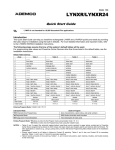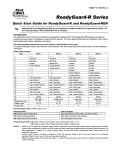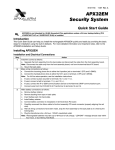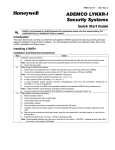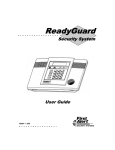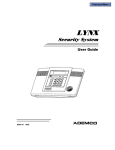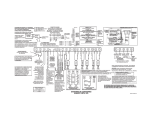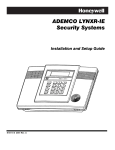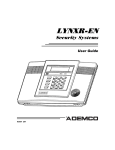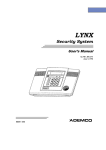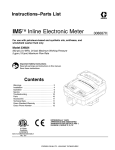Download Lynx Quick Start
Transcript
Previous Menu N8889QS 10/98 /<1; ® 4XLFN6WDUW*XLGH Introduction This Quick Start Guide can help you install the LYNX quickly and easily by providing the basic steps for installation using the built-in defaults. For more detailed information and important notes, refer to the LYNX Installation Instructions. The following steps assume that one of the system’s default tables will be used. For programming data values and Powerline Carrier Devices other than those listed in the default tables, see the Installation Instructions. Default Table Summary Zone Table 1 1 2 3 4 5 6 7 8 9 26 27 28 29 30 31 32 33 92 99 User Code Install Code ------front door back door window motion detector ------------------------loop 3 arm away loop 2 disarm loop 4 close device 1 loop 1 restore device 1 loop 3 arm away loop 2 disarm loop 4 close device 1 loop 1 restore device 1 duress silent alarm 1-2-3-4 4-1-1-2 Table 2 Table 3 Table 4 Table 5 ------front door back door window motion detector smoke detector ------------------‡ ‡ ‡ ‡ ‡ ‡ ‡ ‡ duress silent alarm 1-2-3-4 ------front door back door window window window window motion detector smoke detector ‡ ‡ ‡ ‡ ‡ ‡ ‡ ‡ duress silent alarm 1-2-3-4 ------front door back door window window window window motion detector smoke detector ‡ ‡ ‡ ‡ ‡ ‡ ‡ ‡ duress silent alarm 1-2-3-4 ------front door back door window motion detector ------------------------‡ ‡ ‡ ‡ ‡ ‡ ‡ ‡ duress silent alarm 1-2-3-4 4-1-1-2 4-1-1-2 4-1-1-2 4-1-1-2 ‡ zones 26 – 33 are RF button zones and programmed the same as in Table 1. Entering Program Mode: installer code + 8 0 0 Interactive Mode *56 Zone Programming *83 Sequential Mode Used to Program Zone characteristics, report codes, and serial numbers *84 Assign Zone Voice Descriptors Exiting Program Mode: 5800 Series transmitter serial numbers Voice descriptors for each zone *99 allows re-entry into the Program mode using Installer Code + 8 0 0. *98 inhibits re-entry into the Programming mode using the Installer Code. NOTES: • Tables 2 and 4 support the automatic paging feature (open/close events reported to pager phone number), and a Powerline Carrier Device programmed as device 8, which closes and stays closed upon burglary alarms and restores after bell timeout. For other applications or actions (e.g., using a pulsing siren), see the *80 Powerline Carrier Device Programming section of the Installation Instructions. • Primary report format for all tables is Ademco’s Contact ID reporting. Tables 2 and 4 also use Contact ID for secondary reporting. Tables 1, 3, and 5 use 4+1 format for secondary reporting. • Tables 1 and 5 record all events in the event log. Tables 2, 3, and 4 record only alarms, alarm restores, troubles, and trouble restores in their event logs. Steps to Installing LYNX 1. Separate the front assembly from the back plate and mount the back plate. DO NOT disconnect the ribbon cable from the terminal strip board. Disconnect the cable only from the front assembly board. 2. Make wiring connections as follows: Connect the incoming phone line to either the 8-position jack or terminals 2 (TIP) and 3 (RING). Connect the handset phone lines to either the RJ11 jack or terminals 4 (TIP) and 5 (RING). NOTE: For full line seize operation, see the installation instructions. If used, connect a piezo sounder to terminals 10 (+) and 11 (–). If used, connect a bell to terminals 11 (–) and 12 (+). If using Powerline Carrier Devices, connect com/data/sync/ lines from the PL513 Powerline Interface Module to terminals 9, 13, and 14 respectively. Install Powerline Carrier Devices according to their instructions. Connect wires from the 1332 (1332CN) AC Transformer to terminals 15 and 16. 3. After all wiring connections are made, carefully reconnect the ribbon cable to the front assembly PC board connector (properly aligning the red wire), then snap the front assembly to the back plate so it is held by the locking tabs. Plug the transformer into a 24-hour, 110VAC unswitched outlet. Slide out the battery drawer and install either a single 9V alkaline battery or six 1.5V “AA” alkaline batteries. Use only nonrechargeable, alkaline batteries. After installing the battery(ies), slide the battery drawer into the back plate only after AC power has been applied. 4. Set a programming default: Enter Programming mode: Installer Code + 8 0 0. Press *97, then press a number 1-5 to select a default table from the tables listed on page 1. 5. Program the variable data fields: Press *24 (RF House ID), then enter the desired 2-digit RF House ID for wireless keypads. Press *40 (PABX Code, if used), then enter up to 6 digits. If fewer than 6 digits are used, press [*] to end the field and advance to the next field. Press *41 (Primary Phone Number), then enter the primary phone number, up to 20 digits. If fewer than 20 digits are used, press [*] to end the field and advance to the next field. Press *42 (Secondary Phone Number) if used, then enter the secondary phone number, up to 24 digits. If fewer than 24 digits are used, press [*] to end the field and advance to the next field. Press *43 (Primary Account Number), then enter the primary account number. If only 3 digits are used, press [*] to end the field and advance to the next field. Press *44 (Secondary Account Number) if used, then enter the secondary account number. If only 3 digits are used, press [*] to end the field and advance to the next field. Press *88 (Pager Characters) if using Default Table 2 or 4, then enter up to 16 digits which may be required by your pager service (e.g. account number, PIN, etc.). If fewer than 16 digits are used, press [*] to end the field and advance to the next field. Press *94 (Download Phone Number), then enter the downloading computer phone number, up to 20 digits. If fewer than 20 digits are used, press [*] to end the field. 6. Enroll transmitter serial numbers by pressing *83 while in Programming mode, then follow the prompts: % ' b Enter the 2-digit zone number of the first transmitter whose serial number you are entering, then press [*]. The system displays the “C” prompt. Enter the 7-digit serial number (printed on the transmitter). If you enter an incorrect digit, press the [#] key to back up to that digit and reenter the correct digit. When all 7 digits are entered, press the [*] key. Review the displayed serial number. If correct, press [*] again to save it. The next zone number to be enrolled will display at the “C” prompt for 30 seconds. If this is the desired zone number, enter its serial number as described above. If not, either wait 30 seconds or press the [#] key to display the “b” prompt. The system automatically displays the next zone number for which a serial number may be enrolled. Press [1] to return to the “C” prompt described above to enroll this zone. If the zone number displayed is not desired, press [0] to return to the “A” prompt, where you can then enter a different zone number. After all serial numbers have been enrolled, return to the “A” prompt, then enter [00] to exit enrollment mode (blinking “83”). Press [*] + [99] to exit Program mode. Page 2 7. Set RF House ID in the wireless keypads as follows: If using a 5827 wireless keypad, set the keypad’s DIP switches to the RF House ID programmed in field *24. If using a 5804BD button key or 5827BD keypad, set the RF House ID per its instructions. If using Powerline Carrier Devices, set their House ID to “A,” (programmed as “0”) or use field *25 to change the ID to avoid conflicts with existing installations. 8. Set the Real-Time Clock as follows: Enter time/date setting mode by entering the Installer Code + [63]. The hour prompt is displayed. Enter the correct hour, then press [*] to accept and advance. For each subsequent prompt, enter the correct value, then press [*]. You will exit this mode automatically after entering the year, or if no keys are pressed for 1 minute. 9. Test the system as follows: After installation and programming, enter Installer Code + [5]. To exit Test mode, enter Installer Code + OFF. 10. Assign desired User Codes by following the procedures on the next page and in the User Guide. Show the user how to perform the various system functions. 11. Perform site-initiated downloader session (to load central station ID) by Installer Code + [#] + [1]. RJ11 8 POSITION JACK TO HANDSET PHONE LINE INCOMING PHONE LINE ZONE N/U PHONE EARTH GROUND 2 3 4 TIP RING TIP 1 5 6 RING (+) 8 7 ( ) SOUNDERS PLCD 9 10 11 12 ( ) (+) ( ) (+) AC 15 14 13 16 DATA SYNC OUT IN HARD WIRED ZONE POWERLINE CARRIER DEVICES WARNING: TO PREVENT RISK OF SHOCK, DISCONNECT TELEPHONE LINE AT TELCO JACK BEFORE SERVICING THIS UNIT. ALL OUTPUT CIRCUITS ARE POWER LIMITED. PLUG-IN TRANSFORMER (e.g., ADEMCO 1332) CANADA USE 1332CN LOCAL SOUNDER DISABLE JUMPER CUT = DISABLE } } THIS EQUIPMENT SHOULD BE INSTALLED IN ACCORDANCE WITH THE NATIONAL FIRE PROTECTION ASSOCIATION’S STANDARD 72, CHAPTER 2 (NATIONAL FIRE PROTECTION ASSOC., BATTERYMARCH PARK, QUINCY, MA 02269). PRINTED INFORMATION DESCRIBING PROPER INSTALLATION, OPERATION, TESTING, MAINTENANCE, EVACUATION PLANNING AND REPAIR SERVICE IS TO BE PROVIDED WITH THIS EQUIPMENT. EARTH INCOMING GROUND PHONE LINE PIEZO HANDSET PHONE LINE BELL 9VAC 15VA 6-14VDC 6-14VDC 30mA max. 120mA max. (e.g., WAVE2EX) 2k OHMS EOLR TO 24HR 110VAC UNSWITCHED OUTLET NOTE: BACKUP BATTERY IS REQUIRED. USE SINGLE 9V ALKALINE BATTERY (e.g., DURACELL PC1604 PROCELL) OR SIX 1.5V ALKALINE “AA” BATTERIES (e.g., DURACELL MN1500). REPLACE BATTERY AT LEAST EVERY YEAR. WEEKLY TESTING IS REQUIRED TO ENSURE PROPER OPERATION OF THIS SYSTEM. BLACK PL513 YELLOW POWERLINE INTERFACE RED GREEN THIS DEVICE COMPLIES WITH PART 15 OF FCC RULES. OPERATION IS SUBJECT TO THE FOLLOWING TWO CONDITIONS: (1) THIS DEVICE MAY NOT CAUSE HARMFUL INTERFERENCE, AND (2) THIS DEVICE MUST ACCEPT ANY INTERFERENCE RECEIVED, INCLUDING INTERFERENCE THAT MAY CAUSE UNDESIRED OPERATION. FCC ID: CFS8DLLYNX CANADA: 17481021165A COMPLIES WITH FCC RULES, PART 68 FCC REGISTRATION No. 5GBUSA-25623-AL-E RINGER EQUIVALENCE: 0.6B 1234 4-WIRE MODULAR PHONE CORD WITH FLYING LEADS LYNX WIRING CONNECTIONS 5800 Series Transmitter Loop Numbers: The following illustration shows the compatible transmitters and their associated input types and loop designations. LOOP 3 LOOP 2 LOOP 2 (REED) (REED) LOOP 2 LOOP 1 LOOP 4 YOU MUST ENROLL THIS BUTTON LOCKING TABS 5801 ENROLL AS "UR" OR "RF" LOOP 1 (TERMINALS) LOOP 1 (TERMINALS) LOOP 1 ALTERNATE POSITION FOR LOOP 2 5816 ENROLL AS "RF" 5802/5802CP ENROLL AS "BR" 5816MN ENROLL AS "RF" LOOP 1 YOU MUST ENROLL THIS BUTTON LOOP 4 1 LOOP 3 (PRIMARY) LOOP 2 (AUX. CENTER) LOOP 1 (AUX. RIGHT) 2 16 3 LOOP 1 5827 SET HOUSE CODE LOOP 2 5804 ENROLL AS "BR" RED WIRE MARKING (REED) LOOP 1 (TERMINALS) LOOP 2 DISCONNECT THIS END ONLY! LOOP 1 5818 ENROLL AS "RF" 5817 ENROLL AS "RF" 5802MN ENROLL AS "UR" OR "RF" YOU MUST ENROLL THIS BUTTON LOOP 4 LOOP 3 (TERMINALS) LOOP 3 5827BD SET HOUSE CODE 5819 ENROLL AS "RF" LOOP 1 LOOP 1 5806/5807/5808 •• • •• NOTE: MAKE SURE BATTERY CLIPS ENTER SLOTS WHEN SNAPPING FRONT ASSEMBLY TO BACKPLATE •• • • •• • •• • •• •• BATTERY CLIPS SET HOUSE CODE (5806 SHOWN) LOOP 1 LOOP 1 ENROLL AS "RF" (MOTION) (MOTION) 5804BD ENROLL AS "BR" 5849 ENROLL AS "RF" Page 3 5890 ENROLL AS "RF" Keypad Functions (when default programming is used) Security Functions Checking system status: (high level messages); press STATUS To arm in STAY mode: Press and hold down To restart exit delay: (or enter your code + STAY (or enter your code + AWAY To arm with NO DELAY: Press and hold down or AWAY To disarm the system and silence alarms: User Code + To bypass a zone(s): User Code + To turn Chime mode on or off: BYPASS + FUNCTION + FUNCTION ) See note below. FUNCTION OFF + PLAY + VOLUME + CODE TEST To turn Test mode off: User Code + OFF + VOLUME + [3] (Up) or [6] (Down) OFF + [3] or [6] + LIGHTS ON # + or LIGHTS OFF LIGHTS ON or + device number LIGHTS OFF + dev. no. + user number + User’s Code (see note below) To delete a User Code (except Master Code): Master Code + To turn Test mode on: User Code + FUNCTION + [63] FUNCTION FUNCTION + VOLUME To activate or deactivate devices 7 & 8: User Code + To add a User Code: Master Code + See note below. OFF FUNCTION Other Functions To set the time and date: User Code + To activate or deactivate devices 1-6: NO DELAY RECORD FUNCTION To restore announcement sounding: See note below. CHIME Volume Control To adjust message playback/system announcement volume: To mute system announcements: + STAY AWAY ) + 2-digit zone number(s) To stop recording before end of 20 seconds: To play back a message: STAY (applies only if system is armed in Stay mode) STAY To arm in AWAY mode: Press and hold down Message Center To record a message: again for secondary messages. STATUS To use the defined AUX function: Press and hold AUX CODE + user number key 2 secs (4 beeps) + User Code (To define the AUX function, refer to the procedure in the Aux Function section of the User Manual. Note: The 1-button paging feature [field *87] is not enabled with the default programming) NOTE: The Babysitter Code and Installer Code cannot disarm the system unless it was the code used to arm the system. In addition, if the system is armed by pressing and holding the Quick-Arm buttons, neither the Babysitter Code nor the Installer Code can disarm the system. REFER TO THE INSTALLATION INSTRUCTIONS FOR THE LIMITATIONS OF THIS SYSTEM AND WARRANTY INFORMATION. ¬146l N8889QS 10/98 165 Eileen Way, Syosset, New York 11791 Copyright © 1998





